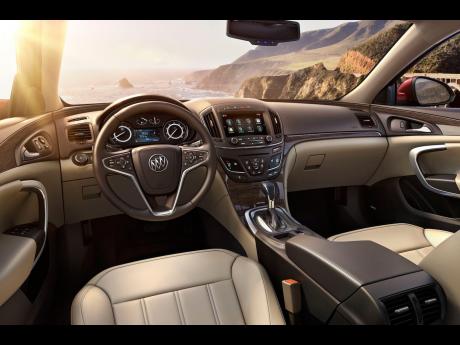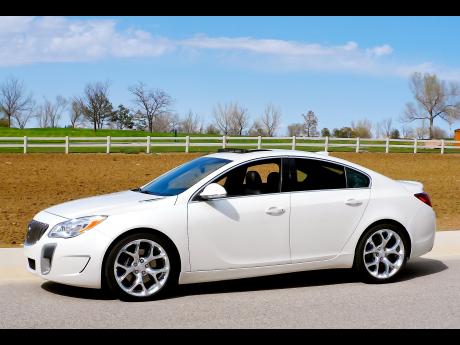The GM brand that nearly died and the unlikely buyers saving it
Brothers Matt and Andy Wonnacott of Livonia, Michigan, are young, single guys who choose to drive Buicks.
They are atypical Buick buyers given its reputation as an old-man sedan brand. But the Wonnacotts are unfazed.
"Look at them now. They don't look like old people's cars," said Matt Wonnacott, 37, who described his 2015 Buick Regal sedan as fast, reliable, and stylish. "I don't care about perception. I just want what makes me happy."
Andy Wonnacott, 32, has been so pleased with Buick, he is on his second Verano compact sedan in red. He said he's "hooked" on the brand.
"They are nice-looking, reliable and conventional cars," Andy Wonnacott said.
The Wonnacotts exemplify a remarkable image change by General Motors.
Buick was the highest-rated US car brand for dependability in J.D. Power's ratings this year. It is pushing up against Mercedes Benz for a top spot in consumer consideration as measured by Kelley Blue Book.
It is GM's second-biggest-selling brand globally behind Chevrolet. And, through stylish design, new SUV and crossover entrants and consistent advertising, Buick has done what GM's luxury brand, Cadillac, has not: achieved a brand renaissance that drives increased new-car sales and attracts younger buyers.
"Cadillac can learn a lot from Buick," said Rebecca Lindland, executive analyst at Kelley Blue Book in New York. "Cadillac needs to have more SUVs, and they need to be really nice."
If Buick leaders want continued success, they must sharpen the marketing message to better articulate the reasons to buy a Buick, experts said.
"The advertising that says, 'Wow, that's a Buick?' is ready to evolve beyond the apology," Lindland said. "They don't have anything to apologise for anymore."
At a glance, Buick's success story is simple. Call it luck or genius, but less than a decade ago, Buick's marketing and product developers foresaw consumers' evolving preference for SUVs and crossovers instead of sedans.
Under GM product boss Mark Reuss, designers and engineers moved swiftly to create hot-looking Buick SUVs. Buick's advertising team rebranded it as hip, and the business model locked it in a niche where it successfully toggles between luxury and mainstream.
Meanwhile, Buick has become integral to GM's profits. It is GM's biggest-selling brand in China, the world's largest car market.
That is a remarkable feat considering that 10 years ago, Buick's sales sputtered, and the brand teetered on the edge of GM's chopping block, with now-defunct Pontiac and Saturn brands.
Yet at the end of the first quarter, Buick was nipping at the heels of Mercedes Benz for consumer consideration, coming in sixth overall among 17 luxury brands, according to Kelley Blue Book's BrandWatch quarterly survey. Cadillac was in the seventh spot for consideration in the survey results, Lindland said.
For the first quarter, GM reported that Buick's global sales rose 9.2 per cent to 332,321 vehicles. A decade earlier, in the first quarter of 2008, Buick reported that it sold 122,412 cars, a Buick spokesman said.
"Buick is capturing attention," said Phil Brook, Buick and GMC's vice-president of marketing.
It caught the eye of 38-year-old Lauren Scott of Springfield, Missouri. She traded in her Chevrolet Cobalt compact sedan for a Pacific Blue 2017 Buick Encore compact SUV last summer.
"I just really like Buick. My grandparents had Buicks, and the view of Buick was it was for old people," Scott said. "But when you take it on the road, it is like sitting on a couch. And it is really cute."
Nearly three-quarters of Buick's sales currently come from crossovers and SUVs, compared with 2013 when most Buick's sales came from sedans, Lindland said.
"They moved very fast in that SUV space and they brought out very nice products," Lindland said. "They've done that premium step that separates them from Chevrolet."
Buick's Brook characterises the vehicles as affordable luxury. Year to date, Buick's average transaction price for cars is US$31,009. For crossovers, it is US$28,715, a Buick spokesman said. Buick's new Avenir sub-brand, which represents about 20 per cent of Enclave sales, is upscale and priced at US$53,500, compared with US$40,000 for an Enclave.
Kelley Blue Book's estimated average transaction price for light vehicles in the US was US$35,285 in March 2018. For luxury compact SUV and crossovers, it was US$44,497.
COMPETITIVE EDGE
Buick's position between volume and luxury currently gives it a competitive edge, said David Sargent, vice-president J.D. Power's global automotive in Los Angeles. But, he said: "There is always a fear of a squeeze-out if true luxury brands come down market a bit," and some volume brands go upscale.
Buick has locked in a reputation for quality, though. J.D. Power's 2018 US Vehicle Dependability Study, released early this year, ranked Buick third, topped only by Porsche and Lexus.
Chevrolet is ranked sixth, but GMC falls below the industry average as does Cadillac, which landed 27th out of the 31 brands. The study measures the number of problems per 100 vehicles original owners experienced during the past 12 months of 2015 model year cars.
The Enclave SUV, which launched in 2007, helped spark the brand's transformation, Lindland said.
Brook said that Buick leaders then looked for "white space opportunities" to make the brand stand out in the crowded car market. One of those was tiny SUV space made with Buick Encore in 2013.
"We had to create that (small SUV) segment. That wasn't something that existed in the US a few years ago," Brook said. "Now, everyone is rushing to get in it."
The sporty Buick Cascada convertible coupe, which went on sale in 2016, drew new customers to the brand, Brook said.
"We really tried to break down the old stereotypes of what people thought," Brook said.
Another 'white space' product is the 2018 Buick Regal TourX hatchback wagon, he said.
"We think of ourselves as a big, small brand," Brook said. "We have the resources of General Motors behind us making us big, but we're small and agile enough to take advantage of trends in the markets."
Buick has also served as a guinea pig to test new products and technology before GM takes it to other brands.
Last fall, Buick put the air ioniser, which purifies the air inside a car, in the 2018 Encore in China, US, Mexico, and Canada, and the 2018 Enclave in North America. It has continued to roll out the air ioniser with the 2019 LaCrosse sedan and Envision compact SUV in all markets. If it's a hit, other GM brand cars might get it.
"It's something the China market is interested in because they have some air-quality issues," Brook said. "We're progressively rolling it out now."
Buick is also a desired destination now for GM designers, Brook said.
"Buick was a brand people weren't lining up to work on. Now we have people putting their hands up," Brook said. "They're young people who are willing to push the envelope a little bit because they can."
One of those is Miljan Jevremovic. The 33-year-old worked nine years designing cars for Toyota until about two years ago when he joined Buick as creative designer of vehicle exteriors.
"Anybody can design a great Lamborghini," Jevremovic said. "But when you're given challenges to design a vehicle at a certain price point to appeal to a mass of people - and on a budget - that's when we do our jobs."
MORE POTENTIAL
Jevremovic wanted to work specifically on Buick to be "at the forefront of something special". He said that he has no desire to work on any other GM brand.
"I love Buick because it's scratching the surface and there is more potential," Jevremovic said.
Buick is now positioned to become a brand of choice among millennials and Gen Z people, analysts said. Its designers purposely aim for buyers in this age range, said Aaron Stich, creative designer of Buick Interiors.
"There is no preconceived notion of Buick among them," Stich said. "It's a blank slate."
Stich, 31, came to Buick in 2013. Before that, he worked on Chevrolet exterior vehicle design for about three years. His Buick team has a mantra, "We say in the studio, 'Design a car you'd want to drive.'"
It is making progress with younger consumers, data show. Buick uses J.D. Power's Power Information Network (PIN) data. It showed in 2008 that the average age of a Buick buyer was 63. This year, it has dropped to 58, Brook said.
"Buick buyers have got younger, but they're still much older than anyone in the industry, other than Cadillac," said Alexander Edwards, president of Strategic Vision in San Diego. The median age for Cadillac and Lincoln is 64, both up slightly from a decade earlier. The age for BMW is 47 compared with 48 in 2008.
"The implication with this is that Buick has done a good job, especially in recent years, of reaching out to younger buyers, but it's mostly through good product," not strong marketing, Edwards said.
Andy Wonnacott said Buick's advertising did pique his interest.
"I appreciated what Buick was trying to do," said Andy Wonnacott, "They started the ad campaigns that I see on TV and you think, 'That's not bad.'"
Buick's Brook said consistent advertising helped "move the needle" on sales, but he admitted that the early Buick spots were a bit on the "apologetic side."
He promised that Buick's new ads will move away from the message, "That's a Buick with a question mark' to 'That's a Buick with an exclamation point.' Our plan is to continue with what's working. Have we got more work to do? Absolutely!"
- Contributed


